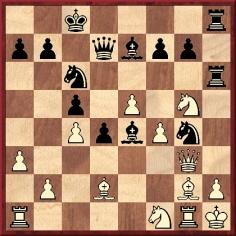
Edward Winter
After White’s tenth move Teichmann remarks, ‘White’s game soon becomes altogether hopeless, and the tragi-comic conclusion seems a just punishment for having missed the right moment to resign’. A punishment for Müller but a treat for us. A smothered mate is unusual enough, but rarer still is a king choked not by pawns but by pieces.
Oscar Conrad Müller – Henry Vincent Crane1 d4 d5 2 c4 e5 3 dxe5 d4 4 a3 c5 5 f4 Nc6 6 Nf3 Bf5 7 g3 Be7 8 Bg2 h5 9 O-O h4 10 Qe1 hxg3 11 Qxg3 Rh6 12 Kh1 Rg6 13 Qe1 Qd7 14 Rg1 O-O-O 15 Nbd2 Nh6 16 Nf1 Rh8 17 Bd2 Ng4 18 e4 Bxe4 19 Ng5 Rgh6 20 Qg3

20...Rxh2+ 21 Nxh2 Rxh2+ 22 Qxh2 Nf2 mate.
Source: BCM, January 1907, page 36.
The position below arose after 40 moves in a game between S. Levitzky and M. Chigorin at a tournament in Moscow on 1 October 1899:
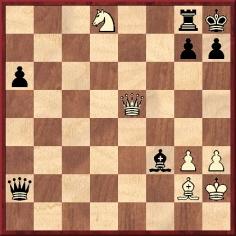
White, to move, is threatened with mate at g2. In desperation he played the neat, if forced, move 41 Qb2. The game ended 41...Qd5 42 Bxf3 Qxd8, after which White resigned.
Source: Wiener Schachzeitung, November 1899, pages 182-184.
This smothered mate often occurs through a familiar manoeuvre involving a different kind of queen sacrifice:
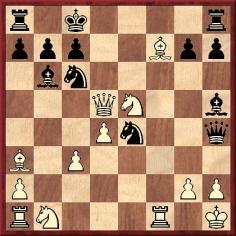
W. Steinitz – R. Stein, New York, 27 November 1884 (simultaneous exhibition against 22 players). White to move.
Steinitz announced mate in five moves by 16 Qe6+ Kb8 17 Nd7+ Kc8 18 Nxb6+ Kb8 19 Qc8+ Rxc8 20 Nd7 mate. In his annotations (International Chess Magazine, January 1885, pages 24-25) he described this as ‘an ordinary version of the smothered mate’, and it had indeed already been known for many centuries.
When the king is not mated in the corner, the winner may need help from an advanced pawn:
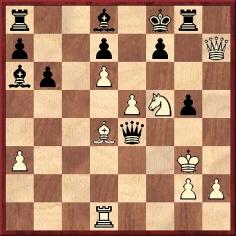
G. Mackenzie mated in five moves: 28 Qh6+ Ke8 29 Ng7+ Kf8 (If 29...Rxg7 then 30 Qh8+) 30 Ne6+ Ke8 31 Qf8+ Rxf8 32 Ng7 mate.
Source: Brooklyn Chess Chronicle, 15 September 1884, page 184.
One of the great beauties of chess is the way a theme may lend itself to countless variants. In the next example, taken from the BCM of June 1920 (page 171), there is a pin on the white queen. The players’ names are not recorded.

Black to move
Play went 1...Rxg2 2 Qxg2 Qg1+ 3 Rxg1 Nf2 mate.
Sometimes a little preparatory work is required:

F. Dus-Chotimirsky – Penin, St Petersburg (date?). Black to move.
1...Nh3 2 Rf1 Rd2 3 Nxd2 Qg1+ 4 Rxg1 Nf2 mate.
Source: Deutsches Wochenschach und Berliner Schachzeitung, 28 August 1910, page 314.
Finally, the smothering manoeuvre may merely be the preface to a different winning motif, such as the so-called corridor mate:
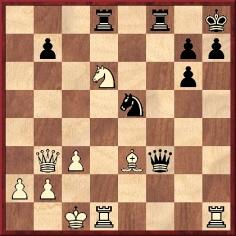
Won by Edmond Gestesi in Paris
1 Bc5 Nd3+ 2 Kb1 Nxc5 3 Nf7+ Kg8 (3...Rxf7 4 Rxd8+ Rf8 was
necessary.) 4 Nh6+ Kh8 5 Qg8+ Rxg8 6 Nf7+ Qxf7 7 Rxh7+ Kxh7 8 Rh1
mate.
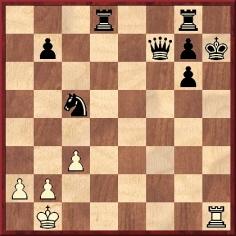
Source: BCM, July 1911, page 276.
(KCK, pages 45-48)
In a review of 1 P-KB4 (A Guide to Bird’s Opening) by R.E. Robinson (Liverpool, 1950) on page 290 of the September 1950 BCM J.M. Aitken wrote:
‘In scope and contents this book is so much out of the ordinary run that it can fairly be termed unique. It contains 248 examples of Bird’s Opening, selected from over a century of tournament chess …’
We wonder whether ‘unique’ is also an appropriate term to describe the smothered mate in a game given on page 100 of Robinson’s book:
F.W. Viney – H.F. Gook1 f4 e6 2 Nf3 d5 3 e3 c5 4 b3 Nc6 5 Bb5 Bd7 6 Bb2 Nf6 7 O-O a6 8 Bxc6 bxc6 9 d3 Bd6 10 Nbd2 Qc7 11 Ne5 O-O 12 Qf3 Rad8 13 Qg3 Ne8 14 Qh4 f6 15 Ng4 Be7 16 Rf3 Rf7 17 Rh3 h6 18 Qh5 Bc8 19 Qg6 Kf8 20 Nf3 d4 21 Qh7 Bd6 22 Nh4 Ke7

23 Ng6+ Kd7 24 Qg8 Re7 25 Nf8 mate.

(3231 & 4178)
A position from page 75 of Better Chess by William Hartston (London, 2003):
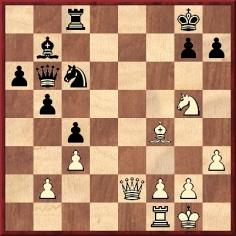
White, to play, gives mate in how many moves? Solution.
(5923)
From page 11 of Wiseman’s Chess Primer by Paul Wiseman (Rothersthorpe, 2011):
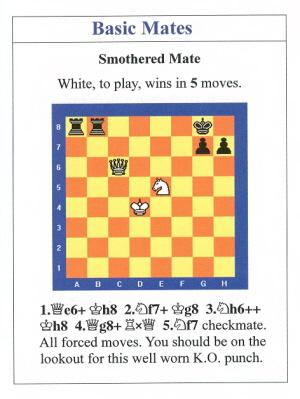
From Christian Sánchez (Rosario, Argentina) comes a combinational finish by Samuel Rosenthal which was given in the chess column of Gastón Pedro Dubox on page 52 of the 11 March 1939 issue of Caras y Caretas:
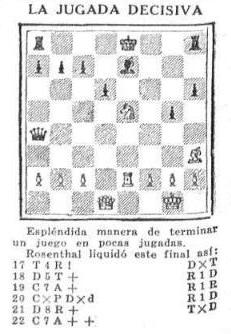
We can add that it was one of two specimens of Rosenthal’s play shown on page 149 of La Stratégie, 15 May 1884:
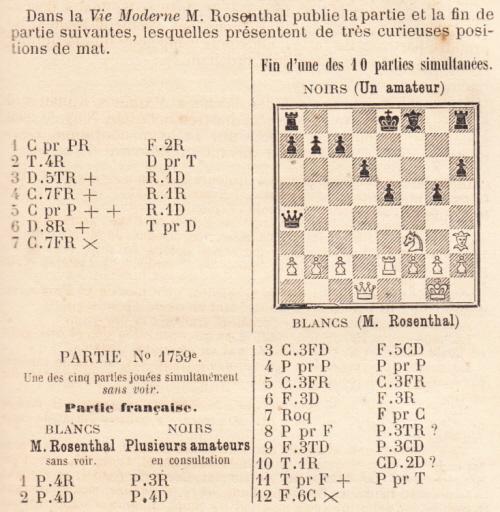
(8373)
This specimen is supplied by Eduardo Bauzá Mercére (New York, NY, USA), from page 2 of the Washington Post, 28 May 1916:
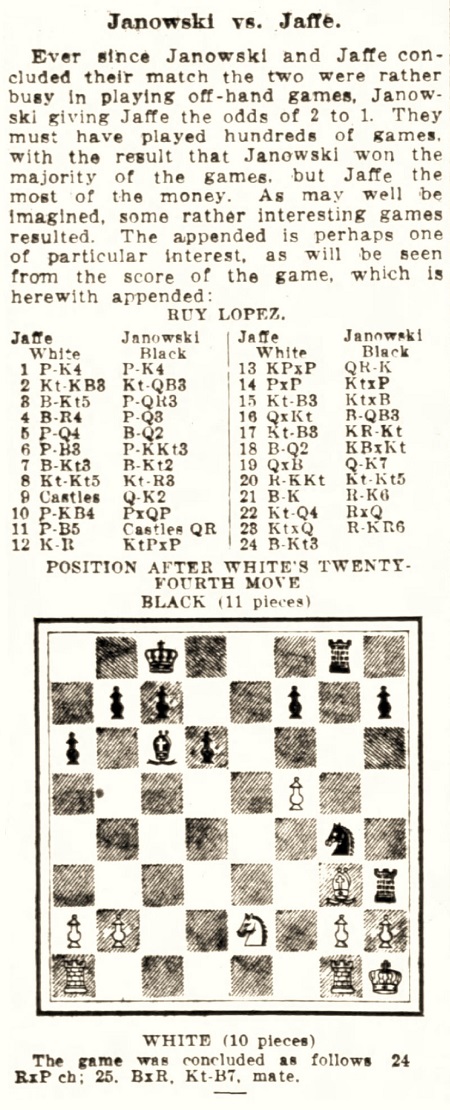
1 e4 e5 2 Nf3 Nc6 3 Bb5 a6 4 Ba4 d6 5 d4 Bd7 6 c3 g6 7 Bb3 Bg7 8 Ng5 Nh6 9 O-O Qe7 10 f4 exd4 11 f5 O-O-O 12 Kh1 gxf5 13 exf5 Rde8 14 cxd4 Nxd4 15 Nc3 Nxb3 16 Qxb3 Bc6 17 Nf3 Rhg8 18 Bd2 Bxc3 19 Qxc3 Qe2 20 Rg1 Ng4 21 Be1
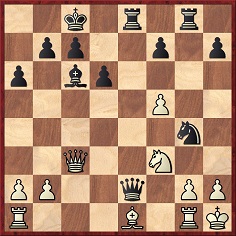
21...Re3 22 Nd4 Rxc3 23 Nxe2 Rh3 24 Bg3 Rxh2+ 25 Bxh2 Nf2 mate.
(10575)
To the Chess Notes main page.
To the Archives for other feature articles.
Copyright: Edward Winter. All rights reserved.